Faculty Of Health Science The Mark Liveris Health Science
Faculty Of Health Science The Mark Liveris Health Science
Faculty Of Health Science The Mark Liveris Health Science
You also want an ePaper? Increase the reach of your titles
YUMPU automatically turns print PDFs into web optimized ePapers that Google loves.
Development of a Web-enabled Spatial Decision Support System (SDSS) ForPrevention of Tick Borne Disease in Kuantan, MalaysiaPresented by: Kasmah Hamid, Department of Spatial <strong>Science</strong>sCourse: Master of PhilosophySupervisors: Dr. Robert Corner, Prof. Geoff West, Dr. Jianhong (Cecilia) XiaTicks are the second most common vector of human disease after mosquitoes. <strong>The</strong>y are found onmany small mammal hosts and also blood-feed on humans with the risk of transmitting diseases.In Malaysia, they are known to cause human otoacariasis disease along the east coast area aswell as being the vector for other diseases such as lyme disease in other countries. Given theimpact of this disease, this study will investigate the potential for a web-enabled spatial decisionsupport system (SDSS) for prevention of tick borne diseases specifically in Kuantan, Malaysia. Inorder to achieve this goal, five specific objectives have been defined, which are 1) to investigatethe major components of a SDDS system, 2) to understand the decision making process forpreventing tick borne disease, 3) to understand the different needs of stakeholders, 4) to explorethe potential of interactive Web 2.0 technologies, and 5) to investigate the Web GeographicInformation Systems (GIS) techniques for disease information management.Four principle study components have been identified. <strong>The</strong>se are: the disease, the user, web GIStechnologies and SDSS components. This study will develop novel spatial methods for an SDSSand show how an SDSS can benefit the users and stakeholders by allowing different levels of userto access and share the information via the World Wide Web (WWW). Furthermore, it willdemonstrate how it can be an effective tool for decision makers to get relevant information at theright time in order to perform disease surveillance, policy making, and to apply disease preventionmethods.A Comparison of Overall <strong>Health</strong> Between Asians and Australians fromEuropean Background: A West Australian Study of Chronic Disease, Diet &Metabolic Syndrome Risk FactorsPresented by: Majid Meshkini, Centre for International <strong>Health</strong>Course: Doctor of Philosophy, International <strong>Health</strong>Supervisors: A/Prof. Jaya Earnest, Dr. Cyril MamotteBackground: In the last three decades, the trend of disease is changing from communicable tonon-communicable chronic diseases like cardiovascular diseases, cancer and diabetes causing aworldwide estimated 35 million deaths annually. Metabolic syndrome and its consequences andimpact have a significant role in burden of disease. Obesity, impaired glucose tolerance, insulinresistance, dyslipidaemia and high blood pressure are important risk factors for metabolicsyndrome. <strong>The</strong> rate and impact of chronic diseases are increasing in Australia, namely theincidence of Diabetes Mellitus type 2 increased from 2.4% to 3.5% between 1995 and 2005. Inaddition, national health survey in 2004-5 revealed that 18% of Australians, (about 3.5 million), hada circulatory system condition.Aim: <strong>The</strong> main objective of this study is to investigate the effects of ethnicity on metabolicsyndrome risk factors and related components in overweight and obese subjects.Methodology: <strong>The</strong> study design is a randomized, and cross-sectional that investigates thecomponents of metabolic syndrome risk factors on 109 overweight and obese immigrants fromIndia, Iran and European ethnic background. Participants are aged more than 18 years have livedin Australia for at least 5 years. Variables used in the research are categorised in four main groupsthat include - anthropometrical, physical, biochemical, and food items.Results: Results indicate significant differences between Iranian and European migrants in totalbody fat percentage; however the differences between European and Indian as well as Indian andIranian were not significant.


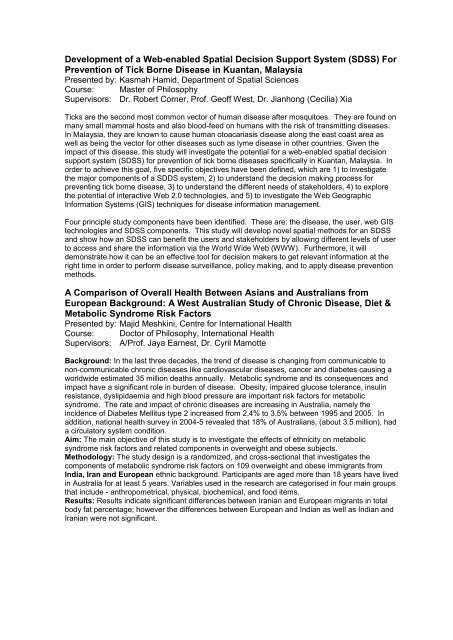
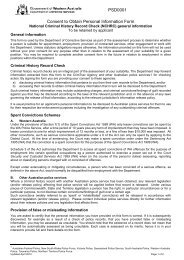

![Mental health commission report July 2010 - June 2011 [.pdf]](https://img.yumpu.com/50755705/1/184x260/mental-health-commission-report-july-2010-june-2011-pdf.jpg?quality=85)
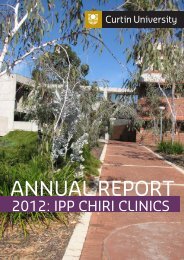
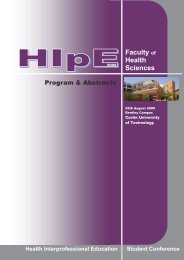

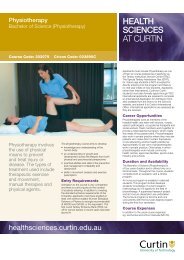



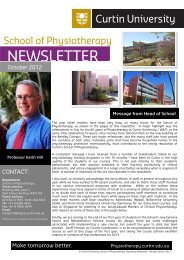
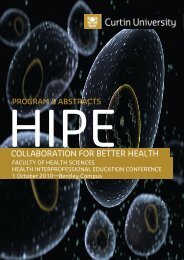

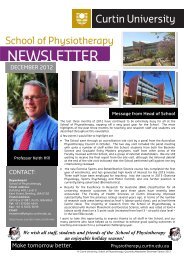
![2007 Annual Report [.pdf] - Health Sciences - Curtin University](https://img.yumpu.com/44476724/1/184x260/2007-annual-report-pdf-health-sciences-curtin-university.jpg?quality=85)